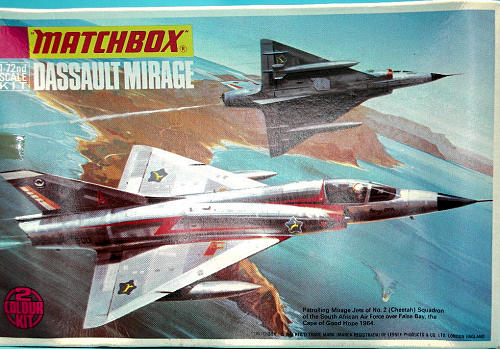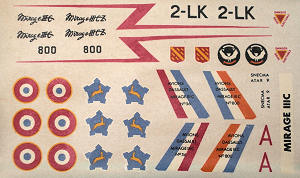Matchbox 1/72 Mirage IIIC
|
KIT: |
Matchbox 1/72 Mirage IIIC |
|
KIT #: |
PK-20 |
|
PRICE: |
$Long out of production |
|
DECALS: |
Two options |
|
REVIEWER: |
Vic Scheuerman |
|
NOTES: |
No Wing Stores |

Based
on a 1952 French Defence Ministry specification for ‘light weight fighter’, the
Mirage 1 prototype flew in June 1955. After tests, the ‘light fighter’ concept
was modified and proposals made for larger and heavier versions.
The proposed III
variant was accepted, and the new fighter flew in November 1956, achieving MACH
1.5 in the following January. Various modifications made to pre-production
aircraft resulted in the first major production version, IIIC.
Flight trials started in October 1960, and aircraft were used in service
by the 2nd, 13th and 5th
ESCADRES
DE
CHASSE of the French Air Force.
A large number of
Mirage aircraft of various types have been exported and are used by many
different Air Forces. A wide variety of underwing stores can be carried and a
rocket motor can be fitted. (Thanks to the kit instruction sheet.)
 Molded
in two shades of Blue, the 26 parts feature a combination of slightly overstated
engraved details (speed brakes look good though) and fine raised panel lines.
As this is an early boxing there is only minute spots of flash and very
minor seam lines. A one-piece clear canopy brings the grand total to 27 parts.
Matchbox did replicate the unusually configured afterburner for the ATAR 09B-3
engine well.
Molded
in two shades of Blue, the 26 parts feature a combination of slightly overstated
engraved details (speed brakes look good though) and fine raised panel lines.
As this is an early boxing there is only minute spots of flash and very
minor seam lines. A one-piece clear canopy brings the grand total to 27 parts.
Matchbox did replicate the unusually configured afterburner for the ATAR 09B-3
engine well.
The kit
cockpit consists of a well sculptured pilot and adequate ejection seat and a
hint of an instrument panel. Very basic, but as the French wisely painted their
cockpits black during the early Mirage days, it will do. Landing gear struts and
tires are petit and look good while the covers are too thick so replacing with
card or sanding them thinner will give a much better final appearance. It is
nice to see all the gear wells fully framed in. Surprisingly, no external stores
are offered. Assembly is covered over six steps in the well illustrated
instruction sheet that has some detail painting notes at the end.

Two natural metal finished Mirages are presented on the kit decal
sheet. A South African of No 2 (Cheetah) Squadron with an attractive red
lighting bolt along the fuselage that matches the red intake lips and red ‘A’ on
the base of the fin. More colours come in the form of the national colours on
the rudder along with the squadron motif on the fin. The ‘Frenchman’ has the
full colour rudder along with the unit crest of the unit; 3e Escadre de Chasse
on the fin. Other then national insignia and the red intake lips, markings are
limited to the black unit identifier on the fuselage. While the kit decals look
nicely printed and in register, I would question their integrity due to age.
The Mirage is a
great looking jet that can be done in a plethora of national markings and
camouflage schemes in the later engine variants. Matchbox’s IIIC is limited to
France,
South
Africa,
Switzerland
and
Israel,
though there are some different camouflage options. The only real niggly about
the kit is a lack of underwing stores. Other then that, paint the cockpit black,
thin the gear doors and find a scheme you like!
Vic
Scheuerman
July 2008
If you would like your product reviewed fairly and quickly, please
contact
me or see other details in the
Note to
Contributors.
Back to the Main Page
Back to the Previews Index Page


 Molded
in two shades of Blue, the 26 parts feature a combination of slightly overstated
engraved details (speed brakes look good though) and fine raised panel lines.
As this is an early boxing there is only minute spots of flash and very
minor seam lines. A one-piece clear canopy brings the grand total to 27 parts.
Matchbox did replicate the unusually configured afterburner for the ATAR 09B-3
engine well.
Molded
in two shades of Blue, the 26 parts feature a combination of slightly overstated
engraved details (speed brakes look good though) and fine raised panel lines.
As this is an early boxing there is only minute spots of flash and very
minor seam lines. A one-piece clear canopy brings the grand total to 27 parts.
Matchbox did replicate the unusually configured afterburner for the ATAR 09B-3
engine well.